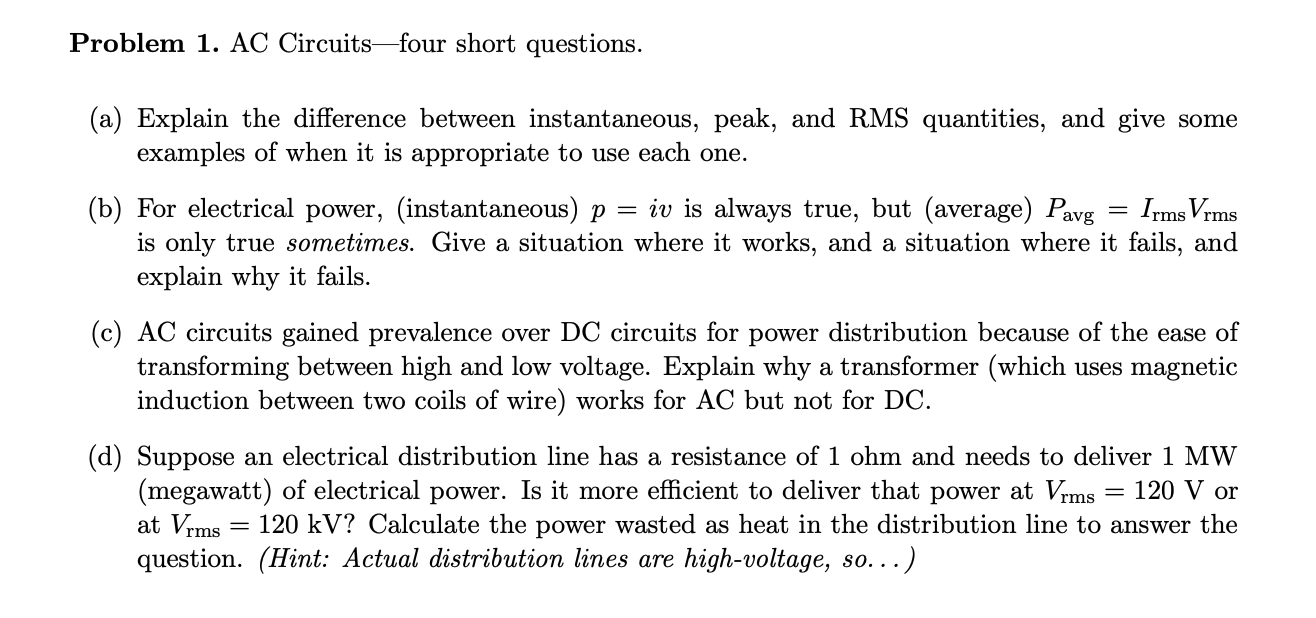Problem 1. AC Circuits-four short questions. (a) Explain the difference between instantaneous, peak, and RMS quantities, and give some examples of when it is appropriate to use each one. (b) For electrical power, (instantaneous) p is only true sometimes. Give a situation where it works, and a situation where it fails, and explain why it fails. = iv is always true, but (average) Pavg Irms Vrms (c) AC circuits gained prevalence over DC circuits for power distribution because of the ease of transforming between high and low voltage. Explain why a transformer (which uses magnetic induction between two coils of wire) works for AC but not for DC. (d) Suppose an electrical distribution line has a resistance of 1 ohm and needs to deliver 1 MW (megawatt) of electrical power. Is it more efficient to deliver that power at Vrms at Vrms question. (Hint: Actual distribution lines are high-voltage, so...) = 120 V or 120 kV? Calculate the power wasted as heat in the distribution line to answer the
Problem 1. AC Circuits-four short questions. (a) Explain the difference between instantaneous, peak, and RMS quantities, and give some examples of when it is appropriate to use each one. (b) For electrical power, (instantaneous) p is only true sometimes. Give a situation where it works, and a situation where it fails, and explain why it fails. = iv is always true, but (average) Pavg Irms Vrms (c) AC circuits gained prevalence over DC circuits for power distribution because of the ease of transforming between high and low voltage. Explain why a transformer (which uses magnetic induction between two coils of wire) works for AC but not for DC. (d) Suppose an electrical distribution line has a resistance of 1 ohm and needs to deliver 1 MW (megawatt) of electrical power. Is it more efficient to deliver that power at Vrms at Vrms question. (Hint: Actual distribution lines are high-voltage, so...) = 120 V or 120 kV? Calculate the power wasted as heat in the distribution line to answer the
Physics for Scientists and Engineers: Foundations and Connections
1st Edition
ISBN:9781133939146
Author:Katz, Debora M.
Publisher:Katz, Debora M.
Chapter33: Inductors And Ac Circuits
Section: Chapter Questions
Problem 36PQ
Related questions
Concept explainers
Applications Of Reflection Of Light
When a light ray (termed as the incident ray) hits a surface and bounces back (forms a reflected ray), the process of reflection of light has taken place.
Sign Convention for Mirrors
A mirror is made of glass that is coated with a metal amalgam on one side due to which the light ray incident on the surface undergoes reflection and not refraction.
Question
Can you answer question D in this image?

Transcribed Image Text:Problem 1. AC Circuits-four short questions.
(a) Explain the difference between instantaneous, peak, and RMS quantities, and give some
examples of when it is appropriate to use each one.
(b) For electrical power, (instantaneous) p
is only true sometimes. Give a situation where it works, and a situation where it fails, and
explain why it fails.
= iv is always true, but (average) Pavg
Irms Vrms
(c) AC circuits gained prevalence over DC circuits for power distribution because of the ease of
transforming between high and low voltage. Explain why a transformer (which uses magnetic
induction between two coils of wire) works for AC but not for DC.
(d) Suppose an electrical distribution line has a resistance of 1 ohm and needs to deliver 1 MW
(megawatt) of electrical power. Is it more efficient to deliver that power at Vrms
at Vrms
question. (Hint: Actual distribution lines are high-voltage, so...)
= 120 V or
120 kV? Calculate the power wasted as heat in the distribution line to answer the
Expert Solution
This question has been solved!
Explore an expertly crafted, step-by-step solution for a thorough understanding of key concepts.
This is a popular solution!
Trending now
This is a popular solution!
Step by step
Solved in 2 steps with 3 images

Knowledge Booster
Learn more about
Need a deep-dive on the concept behind this application? Look no further. Learn more about this topic, physics and related others by exploring similar questions and additional content below.Recommended textbooks for you

Physics for Scientists and Engineers: Foundations…
Physics
ISBN:
9781133939146
Author:
Katz, Debora M.
Publisher:
Cengage Learning

College Physics
Physics
ISBN:
9781938168000
Author:
Paul Peter Urone, Roger Hinrichs
Publisher:
OpenStax College

College Physics
Physics
ISBN:
9781285737027
Author:
Raymond A. Serway, Chris Vuille
Publisher:
Cengage Learning

Physics for Scientists and Engineers: Foundations…
Physics
ISBN:
9781133939146
Author:
Katz, Debora M.
Publisher:
Cengage Learning

College Physics
Physics
ISBN:
9781938168000
Author:
Paul Peter Urone, Roger Hinrichs
Publisher:
OpenStax College

College Physics
Physics
ISBN:
9781285737027
Author:
Raymond A. Serway, Chris Vuille
Publisher:
Cengage Learning

College Physics
Physics
ISBN:
9781305952300
Author:
Raymond A. Serway, Chris Vuille
Publisher:
Cengage Learning


Physics for Scientists and Engineers, Technology …
Physics
ISBN:
9781305116399
Author:
Raymond A. Serway, John W. Jewett
Publisher:
Cengage Learning